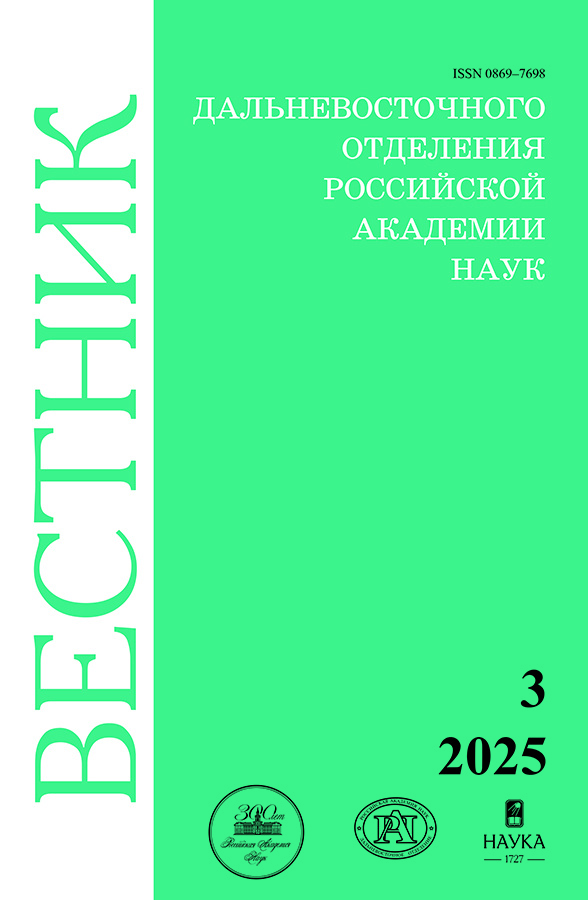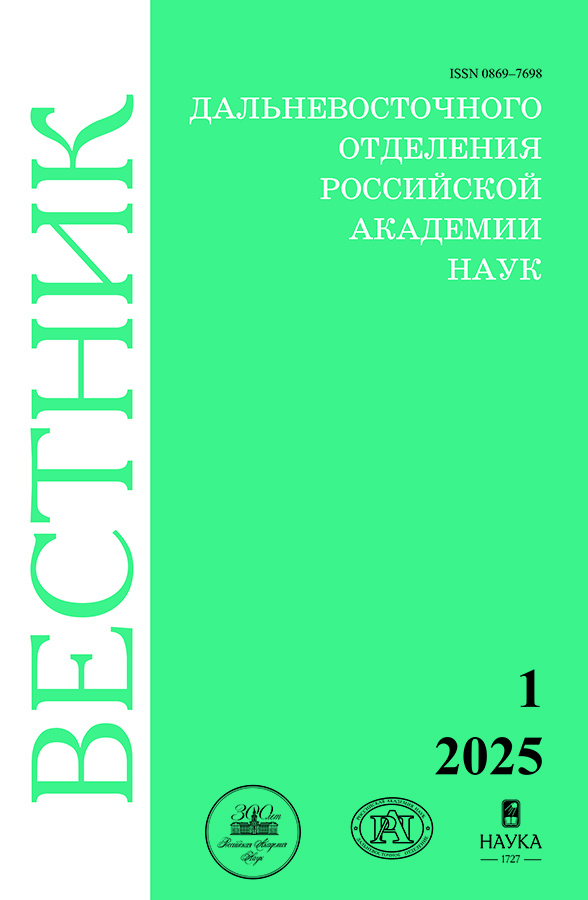Application of metabolomics approaches for the analysis of secondary metabolites of starfish and sea cucumbers at the G.B. Elyakov Pacific Institute of Bioorganic Chemistry, FEB RAS
- Authors: Popov R.S.1, Ivanchina N.V.1, Dmitrenok P.S.1
-
Affiliations:
- Elyakov Pacific Institute of Bioorganic Chemistry of FEB RAS
- Issue: No 1 (2025)
- Pages: 54-68
- Section: Chemical Sciences
- URL: https://permmedjournal.ru/0869-7698/article/view/688867
- DOI: https://doi.org/10.31857/S0869769825010056
- EDN: https://elibrary.ru/HHWXPA
- ID: 688867
Cite item
Full Text
Abstract
Polar steroidal compounds of starfish and triterpene glycosides of sea cucumbers are unique biologically active secondary metabolites with unusual chemical structures and diverse biological effects. The application of metabolomic approaches involving mass spectrometry techniques to the investigation of marine invertebrate extracts makes it possible to detect many previously unstudied, including minor, compounds, to rapidly characterize a complete set of metabolites, to identify known compounds and to infer structures or to obtain information on the structure of specific parts of molecules for new compounds. The article briefly discusses key achievements in the study of secondary metabolites of starfish and sea cucumbers using metabolomic approaches at the G.B. Elyakov Pacific Institute of Bioorganic Chemistry, FEB RAS. The use of mass spectrometry-based approaches to investigate total fractions of polar steroidal compounds from the Far Eastern starfish Aphelasterias japonica (class Asteroidea, order Forcipulatida, family Asteriidae), Patiria pectinifera (class Asteroidea, order Valvatida, family Asterinidae) and Lethasterias fusca (class Asteroidea, order Forcipulatida, family Asteriidae) allowed the detection and structural characterization of a large number of both known and novel steroidal compounds, including asterosaponins, polyhydroxysteroid glycosides and polyhydroxysteroids. In addition, the effect of different stress factors on the steroid metabolome of P. pectinifera and the distribution of detected compounds in different organs of L. fusca were studied. The data obtained allowed us to draw conclusions about the biosynthesis and the biological functions of these metabolites. The application of metabolomic profiling allowed us to characterize the composition of triterpene glycosides of the Far Eastern sea cucumber Eupentacta fraudatrix (class Holothuroidea, order Dendrochirotida, family Sclerodactylidae) and to propose a scheme of their biosynthesis. Based on the data obtained, a spectral library was created for a large number of previously isolated triterpene glycosides.
Full Text
About the authors
Roman S. Popov
Elyakov Pacific Institute of Bioorganic Chemistry of FEB RAS
Author for correspondence.
Email: rs.popov@outlook.com
ORCID iD: 0000-0002-1727-6164
Candidate of Sciences in Chemistry, Senior Researcher
Russian Federation, VladivostokNatalia V. Ivanchina
Elyakov Pacific Institute of Bioorganic Chemistry of FEB RAS
Email: ivanchina@piboc.dvo.ru
ORCID iD: 0000-0001-9075-8584
Candidate of Sciences in Chemistry, Head of Laboratory
Russian Federation, VladivostokPavel S. Dmitrenok
Elyakov Pacific Institute of Bioorganic Chemistry of FEB RAS
Email: paveldmt@piboc.dvo.ru
ORCID iD: 0000-0002-8191-6170
Doctor of Sciences in Chemistry, Director
Russian Federation, VladivostokReferences
- Ivanchina N.V., Kicha A.A., Stonik V.A. Steroid glycosides from marine organisms. Steroids. 2011; 76(5):425–454.
- Ivanchina N., Kicha A., Malyarenko T., Stonik V. Recent studies of polar steroids from starfish: structures, biological activities and biosynthesis. In: Advances in Natural Products Discovery. New York: Nova Sci.; 2017. P. 191–224.
- Stonik V.A., Kicha A.A., Malyarenko T.V., Ivanchina N.V. Asterosaponins: Structures, Taxonomic Distribution, Biogenesis and Biological Activities. Marine Drugs. 2020;18(12).
- Kalinin V.I., Aminin D.L., Avilov S.A., Silchenko A.S., Stonik V.A. Triterpene Glycosides from Sea Cucucmbers (Holothurioidea, Echinodermata). Biological Activities and Functions. In: Studies in Natural Products Chemistry (Bioactive Natural Products). Elsevier Science Publisher; 2008. Vol. 35. P. 135–196.
- Kalinin V.I., Avilov S.A., Silchenko A.S., Stonik V.A., Elyakov G.B. Triterpene glycosides of sea cucumbers (Holothuroidea, Echinodermata) as taxonomic markers. Natural Product Communications. 2015;10(1).
- Kalinin V.I., Silchenko A.S., Avilov S.A., Stonik V.A. Progress in the Studies of Triterpene Glycosides From Sea Cucumbers (Holothuroidea, Echinodermata) Between 2017 and 2021. Natural Product Communications. 2021;16(10).
- Minale L., Riccio R., Zollo F. Steroidal Oligoglycosides and Polyhydroxysteroids from Echinoderms. Prog. Chem. Org. Nat. Prod. 1993;62:75–308.
- Wolfender J.L., Litaudon M., Touboul D., Queiroz E.F. Innovative omics-based approaches for prioritisation and targeted isolation of natural products-new strategies for drug discovery. Natural Product Reports. 2019;36(6):855–868.
- Demeyer M., De Winter J., Caulier G., Eeckhaut I., Flammang P., Gerbaux P. Molecular diversity and body distribution of saponins in the sea star Asterias rubens by mass spectrometry. Comparative Biochemistry and Physiology. Part B: Biochemistry and Molecular Biology. 2014;168:1–11.
- Demeyer M., Wisztorski M., Decroo C., De Winter J., Caulier G., Hennebert E., Eeckhaut I., Fournier I., Flammang P., Gerbaux P. Inter- and intra-organ spatial distributions of sea star saponins by MALDI imaging. Analytical and Bioanalytical Chemistry. 2015;407(29):8813–8824.
- Dahmoune B., Bachari-Houma F., Chibane M., Jéhan P., Guegan J.-P., Dahmoune F., Aissou-Akrour C., Mouni L., Ferrières V., Hauchard D. Saponin contents in the starfish Echinaster sepositus: chemical characterization, qualitative and quantitative distribution. Biochemical Systematics and Ecology. 2021;96:104262.
- Van Dyck S., Gerbaux P., Flammang P. Qualitative and quantitative saponin contents in five sea cucumbers from the Indian Ocean. Marine Drugs. 2010;8(1):173–189.
- Bondoc K.G.V., Lee H., Cruz L.J., Lebrilla C.B., Juinio-Meñez M.A. Chemical fingerprinting and phylogenetic mapping of saponin congeners from three tropical holothurian sea cucumbers. Comparative Biochemistry and Physiology. Part B: Biochemistry and Molecular Biology. 2013;166(3/4):182–193.
- Van Dyck S., Flammang P., Meriaux C., Bonnel D., Salzet M., Fournier I., Wisztorski M. Localization of secondary metabolites in marine invertebrates: contribution of MALDI MSI for the study of saponins in cuvierian tubules of H. forskali. PLoS One. 2010;5(11). e13923.
- Van Dyck S., Caulier G., Todesco M., Gerbaux P., Fournier I., Wisztorski M., Flammang P. The triterpene glycosides of Holothuria forskali: usefulness and efficiency as a chemical defense mechanism against predatory fish. Journal of Experimental Biology. 2011;214(8):1347–1356.
- Bahrami Y., Zhang W., Franco C. Distribution of saponins in the sea cucumber Holothuria lessoni; the body wall versus the viscera, and their biological activities. Marine Drugs. 2018;16(11):423.
- Popov R.S., Ivanchina N.V., Kicha A.A., Malyarenko T.V., Dmitrenok P.S., Stonik V.A. Metabolite profiling of polar steroid constituents in the Far Eastern starfish Aphelasterias japonica using LC–ESI MS/MS. Metabolomics. 2014;10(6):1152–1168.
- Popov R.S., Ivanchina N.V., Kicha A.A., Malyarenko T.V., Dmitrenok P.S., Stonik V.A. LC-ESI MS/MS profiling of polar steroid metabolites of the Far Eastern starfish Patiria (= Asterina) pectinifera. Metabolomics. 2016;12(2):21.
- Ivanchina N.V., Kalinovsky A.I., Kicha A.A., Malyarenko T V., Dmitrenok P.S., Ermakova S.P., Stonik V.A. Two new asterosaponins from the Far Eastern starfish Lethasterias fusca. Natural Product Communications. 2012;7(7).
- Popov R.S., Ivanchina N.V., Kicha A.A., Malyarenko T.V., Dmitrenok P.S. Structural characterization of polar steroid compounds of the Far Eastern starfish Lethasterias fusca by nanoflow liquid chromatography coupled to quadrupole time-of-flight tandem mass spectrometry. Journal of the American Society for Mass Spectrometry. 2019;30(5):743–764.
- Popov R.S., Ivanchina N.V., Kicha A.A., Malyarenko T.V., Grebnev B.B., Dmitrenok P.S., Stonik V.A. LC–MS-based metabolome analysis on steroid metabolites from the starfish Patiria (= Asterina) pectinifera in conditions of active feeding and stresses. Metabolomics. 2016;12(6):106.
- Popov R.S., Ivanchina N.V., Kicha A.A., Malyarenko T.V., Grebnev B.B., Stonik V.A., Dmitrenok P.S. The distribution of asterosaponins, polyhydroxysteroids and related glycosides in different body components of the Far Eastern starfish Lethasterias fusca. Marine Drugs. 2019;17(9):523.
- Popov R., Ivanchina N., Silchenko A., Avilov S., Kalinin V., Dolmatov I., Stonik V., Dmitrenok P. Metabolite Profiling of Triterpene Glycosides of the Far Eastern Sea Cucumber Eupentacta fraudatrix and Their Distribution in Various Body Components Using LC-ESI QTOF-MS. Marine Drugs. 2017;15(10):302.
- Popov R.S., Ivanchina N.V., Silchenko A.S., Avilov S.A., Kalinin V.I., Malyarenko T.V., Stonik V.A., Dmitrenok P.S. A Mass Spectrometry Database for Sea Cucumber Triterpene Glycosides. Metabolites. 2023;13(7):783.
- Wang M., Carver J.J., Phelan V.V., Sanchez L.M., Garg N., Peng Y., Nguyen D.D., Watrous J., Kapono C.A., Luzzatto-Knaan T., Porto C., Bouslimani A., Melnik A.V., Meehan M.J., Liu W.T., Crüsemann M., Boudreau P.D., Esquenazi E. et al. Sharing and community curation of mass spectrometry data with Global Natural Products Social Molecular Networking. Nature Biotechnology. 2016;34(8):828–837.
Supplementary files











